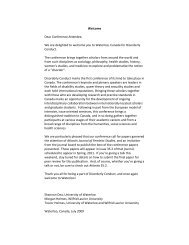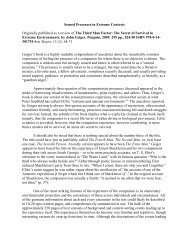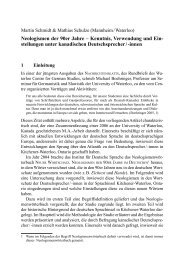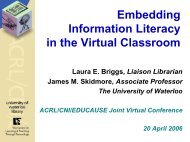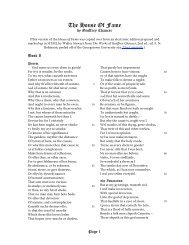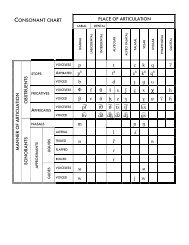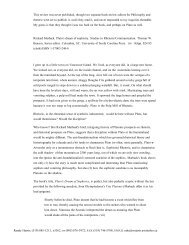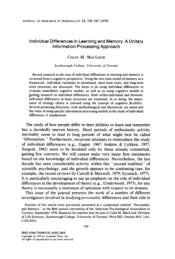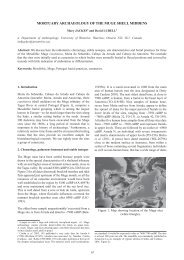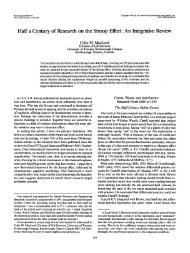The mid seventeenth century collapse of Iroquoian Ontario:
The mid seventeenth century collapse of Iroquoian Ontario:
The mid seventeenth century collapse of Iroquoian Ontario:
You also want an ePaper? Increase the reach of your titles
YUMPU automatically turns print PDFs into web optimized ePapers that Google loves.
M. JackeS<br />
364<br />
Feature 62, from the last decade <strong>of</strong> the Neutral Nation, contained 103 individuals and<br />
illustrates highly ritualized burial practices. Most skulls were laid within the oval formed by<br />
a rampart <strong>of</strong> bundled long bones, and individuals were arranged by status, age, sex and<br />
disabilities. Family groupings are suggested (Jackes, 1988; 1996).<br />
<strong>The</strong> social differentiation apparent from Feature 62, and the possible symbolism <strong>of</strong> the<br />
arrangement as interpreted by Kenyon (1979; 1982), make the idea that Feature 62 represents<br />
the dead, over one winter, <strong>of</strong> one small community very problematic. And yet this would be<br />
the implication <strong>of</strong> Kenyon’s (1982, p. 231) assumption <strong>of</strong> a once-every-summer burial ritual.<br />
In 1640-41, the Jesuits estimated that the villages they entered had around 300 people<br />
each. For a village <strong>of</strong> 300 to lose 103, most <strong>of</strong> them adults, many <strong>of</strong> them senior and important<br />
people, would be devastating. <strong>The</strong> 30 years <strong>of</strong> Grimsby cemetery use would, indeed, imply a<br />
village <strong>of</strong> not much over 300 people for the 373 dead (by one method <strong>of</strong> estimating the<br />
population from which a skeletal sample is drawn [e 0-5 *(total N/30)+3] – the formula is<br />
derived, slightly altered, from Acsádi, Nemeskéri, 1970). Since there is an obvious underrepresentation<br />
<strong>of</strong> infants and young children this cannot be accurate, but experimentally<br />
increasing the numbers <strong>of</strong> dead infants does not markedly increase the estimated population<br />
size.<br />
In fact, if 103 individuals represent the dead <strong>of</strong> only one year, the population size from<br />
which they were drawn would be estimated at nearly 3 400. Feature 62 cannot represent the<br />
dead <strong>of</strong> one huge settlement in one year because the area has been lived in and intensively<br />
farmed by Europeans since 1784: Grimsby and its surrounding countryside is very wellknown,<br />
and there is no record <strong>of</strong> anything but a thin scatter <strong>of</strong> Neutral material <strong>of</strong> the period.<br />
For this reason, it also seems unlikely that the burial represents the dead <strong>of</strong> many years from<br />
one reasonably large village. Furthermore, a lengthy period <strong>of</strong> many years before burial<br />
seems unlikely, especially since the Neutral did not leave their dead in cemeteries while<br />
awaiting the grand ceremonial <strong>of</strong> a mass burial, as amongst the Huron.<br />
If the dead were not buried every year and the 103 represent the dead <strong>of</strong> more than one<br />
year we must consider the possibility that the dead were collected from many communities<br />
and carried to Grimsby as a special burial place. As there is no known village in the vicinity,<br />
and because <strong>of</strong> the time depth, it has been proposed (Kenyon, Fox, 1986) that the cemetery<br />
relates to a ceremonial centre, rather than to a village as such. Given that there are very<br />
specific signs <strong>of</strong> family relationships among the dead (Jackes, 1988; 1996), it seems unlikely<br />
that the dead would have been carried from disparate areas over great distances to be placed<br />
in the Grimsby cemetery. <strong>The</strong> way down through the thick growths <strong>of</strong> pine, oak and hickory<br />
which then grew along the steep escarpment would have been difficult, especially as one<br />
Feature 62 individual must have been given a primary, in-flesh burial, and there were large<br />
numbers <strong>of</strong> grave goods.<br />
Although some grave goods in the cemetery as a whole are indicative <strong>of</strong> unusual materials<br />
brought from outside, Kenyon and Fox (1986, p. 68) state that most projectile points in<br />
the cemetery are made on local Ancaster chert. Lennox and Fitzgerald (1990, p. 420) note that<br />
Ancaster chert is not the most common in Neutral sites generally and was not the highest



